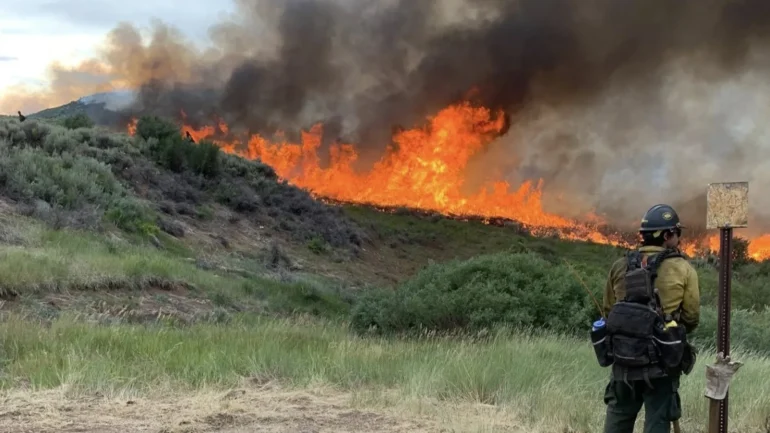In the rugged landscapes of northwestern Colorado, a pair of ferocious wildfires—the Lee Fire and the Elk Fire—are testing the limits of human endurance and nature’s fury. Sparked by lightning strikes just over a week ago, these blazes have scorched more than 120,000 acres combined, forcing evacuations, threatening communities, and even generating their own chaotic weather systems. As firefighters battle on, they cling to hopes of cooler, calmer conditions, but the forecast offers little mercy in the days ahead.
The Lee Fire, the larger and more aggressive of the two, has exploded to over 106,000 acres, making it the sixth-largest wildfire in Colorado’s history. Burning west of the small ranching town of Meeker, about 150 miles from Denver, it has zeroed in on homes, infrastructure, and vital oil and gas resources. At its peak intensity, the fire crept within a mile of Meeker, prompting urgent warnings for residents to prepare to flee. “This is the kind of fire that is really driven in part by the significant drought-stressed fuels that are out there,” explained Bethany Urban, a fire information officer with the Rocky Mountain Area Complex Incident Management Team 3. “It doesn’t actually take that much of a wind to get this fire up and moving in these kinds of fuels.”
Fueled by tinder-dry piñon-juniper forests—made even more combustible by years of drought and the broader impacts of climate change—the Lee Fire has exhibited “extreme fire behavior,” according to officials. On Friday, high winds pushed the blaze southward, limiting aircraft operations and creating a massive pyrocumulus cloud that towered above 30,000 feet. “It starts to create its own weather at that point,” said operations planning chief Tyler Nathe, “and so it was creating some additional outflow and inflow winds at ground level, which was increasing the fire behavior as the main fire front was moving down to the southeast.”
The Elk Fire, burning east of Meeker, has consumed about 14,600 acres and remains a stubborn threat despite slight progress in containment. Together, these fires have drawn over 1,200 firefighters from across the country, a surge made possible by a surprisingly quieter wildfire season in the West this summer. Crews have worked tirelessly, building containment lines along highways and dousing hot spots to shield towns like Meeker. Yet, the dangers are constant: “There have been times where we’ve had to pull firefighters back just to keep them safe,” Urban noted.
The human toll is mounting. Evacuations span Rio Blanco and Garfield counties, affecting homes and even the Rifle Correctional Center, where 179 incarcerated individuals were relocated to safer facilities as a precaution. Governor Jared Polis has formalized an emergency declaration to mobilize state resources, underscoring the crisis on Colorado’s Western Slope.
Local residents, like Michelle Morgan, owner of the Elk Mountain Inn in Meeker, have felt the fear firsthand. Her inn is now packed with fire crews who arrived “so fast” from everywhere. Last week, as flames loomed closer, Morgan loaded her car with irreplaceable items—photo albums, documents, and essentials—bracing for the worst. “From town we had a great show of what it was doing,” she recalled. “That was a little dicey.” Fortunately, containment efforts have buffered the town for now, but the relief is tentative.
Beyond the immediate destruction, the fires are choking the air with hazardous smoke, impacting air quality across western Colorado and even echoing broader concerns seen in other regions, like the Midwest haze from Canadian wildfires. Health experts warn that prolonged exposure to such smoke is akin to smoking half a pack of cigarettes a day, urging people to stay indoors and use air filters.
As of Sunday, the Lee Fire is only 6% contained, while the Elk Fire stands at 9%. Officials report “excellent progress” in some areas, but “near-critical fire weather” persists: low humidity, gusty winds up to 30 mph, and scorching temperatures with no clouds in sight. “The very dry fuels with the expected weather could result in extreme fire behavior in some areas of the fire,” fire teams warned in their latest update.
In a state scarred by past megafires—like the 2020 Cameron Peak Fire, which burned over 208,000 acres—Coloradans know the drill all too well. Yet, the Lee and Elk fires serve as a stark reminder of how climate-driven droughts and overgrown landscapes can turn a spark into a catastrophe. Firefighters remain vigilant, resources continue to flow in, and communities hold their breath. For now, the battle rages on, with all eyes on the skies for a much-needed shift in the weather.
